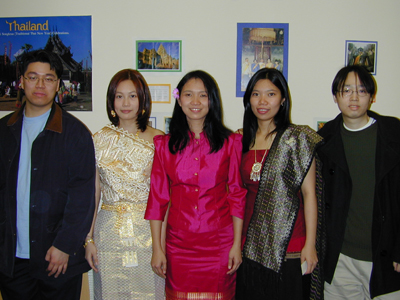April 14, 2001
Maybe it was because I went to an international camp when I was twelve that taught me to be culturally prepared whenever I traveled abroad alone. My mother also encourages me to be the cultural representative in my own term wherever I go. ďWe have rich cultures,Ē she says, ďand you should be proud of that. There are people out there in the world who donít know anything about us, and itís our responsibility as a Thai citizen to educate them.Ē
We came up with the Thai Cultural Survival kit: little souvenirs like key chains and figurines, more expensive souvenirs for Christmas gifts like silk ties and scarves, some postcards, magazine articles and books in English about Thailand, and at least one Thai costume. Ability to cook Thai food is a plus. In addition, optional of course, if you have the time and the budget to learn some dances, Muay Thai, or Thai musical instrument, it doesnít hurt either.
There is always a chance that you would get to whip out your cultural stuff for your class or your activity. When I was in high school, I joined the Multi-cultural Club. My school was predominantly white Americans, so I figured to pull off some cultural stunt by offering to host a lunchtime mini-Loy Krathong (Full moon night in November, Festival of Floats). I managed to find an inflatable pool, made some krathongs from the material my mom sent from home, made flyers about the festival, and had my schoolmates played the temple fair game of trying to hit an underwater target with some coins to win some souvenirs. The festivity got quite a bit of attention that day.
Most universities have some sort of International Student Assembly, and they organize cultural events year round. Your local Thai club might just participate in one of the events, and they might require your assistance. For examples, USC used to have a cultural Friday in the activity center. Students from different country would bring in a sampler of their food, and the ISA would provide beverages. The students then give a small presentation about their country and cultures. Thai club did that once during my undergraduate year, and we had special audiences: a group of 3rd graders from a nearby school. My friend and I, all decked out in our elaborate costumes, took turn narrating the set of slides I brought with me. It was unfortunate that both my friend and I were quite deficient in Thai culinary arts, so we ended up buying some crispy wontons and egg rolls from a local Thai restaurant.
If you can cook, I salute you. Youíre already 90% self-appointed cultural attachť right there! Why, you ask? The first thing that most people would say to you once they know youíre Thai is that they like Thai food. Then the conversation rolls from food to the country and the cultures. And ďCan you cook Thai food?Ē would eventually come up. My mom did lock me in the kitchen many days before I left to make sure that at least I could cook rice on the stove, and make kai jiew (Thai omelet). Really, Iím not a great cook, but I managed. For those who are a natural born chef, you could offer to cook simple dinner for your friends. Believe me. After dinner, youíll have a group of Thai culture enthusiasts in your living room.
Cooking is not something I can do well, but I make up for that by representing Thai culture through my fashion statement. When I returned home each summer, my mom would take me shopping for typical Thai garments like Lae pants (fisherman pants), Moh Homm shirts (Thai denim), hand-woven silk jackets, and northern-style silver jewelry to add to my collection. Thatís right. I proudly strut through campus wearing something of a Thai peasant once in a while. During the summer, I would wear a tank top or T-shirt with Lae pants to class or lounging in the dorm. I did run into some folks from Thai club a couple of times, and they would make fun of me a little bit, but I didnít care. Anyhow, everyone asked about the pants, and the next thing I knew I was taking down order sfor pants to bring back to my peers.
There is no rule here about what you should be wearing to class or anywhere else. Actually, the bohemian, eclectic, ethnic sort of fashion is quite in style nowadays. Itís all about being and expressing yourself. Iím proud that Iím Thai, and I show it with my clothing choice. Coincidently, the summer I introduced Lae pants to my friends, the draw-string pants were popular in the U.S. And then sarong happened to be hip but I was too insecure with how to properly wear a paa toong (sarong for girls) so I skipped out on that one. But I proudly hung my paa toong on my door as decoration though. Got lots of compliments.
The bottom line though is that by just being Thai, you are already a representative of our motherland. With the song and dance, beautiful handicraft, and scrumptious cuisine, you know that you are making an impression on these people who might barely know about Thailand. But then again, you are already educating others with your respect and politeness, strength and bravery, and kindness and courteousness typical of any Thais.

Thai Night picture courtesey of
Thai Student Association, Columbia University, New York.
Related Links